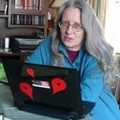Features
net.wars: You own your own 20th anniversary
by Wendy M Grossman | posted on 08 April 2005
Last Friday, April 1, was the 20th anniversary of the WELL , the San Francisco-based conferencing system that might (or might not) be the oldest online conference system still in existence.

How do you celebrate such a thing? The WELL, which for much of its existence ran a monthly office party on its (real-life) premises to which all the membership were invited, clearly had to have a party. A big party. Accompanied by what the WELL calls a "thrash" - that is, a no-holds-barred, public argument with factions and hurt feelings over how to organise it. The upshot was that eventually there were two parties on different nights in different locations: the official party and an grass-roots party the next night. Me, I say harmony was doomed from the first mention of fruitcake.
The San Francisco Chronicle saw the official party as a "tribute to yesteryear", called the members "hippies, freethinkers, and geeks" (as well as "diehards"), and described the average age by saying most had "let their hair go white". (What do you mean, "let it?" You think people when they hit 50 have a conversation with their hair that goes, "Can I go white now? PLEASE? I won't ask for anything else, I promise" and give in because it's easier than being pestered all the time? Hair goes white, that's what it does, and it isn't polite about it. It will come for you, too, one day.)
The good news there is that it gave both party groups a common enemy. The Chronicle didn't go to the grass-roots party, which from all accounts was a happy time with an averagely younger crowd. What the reporter missed was the GenX influx that Katie Hafner documented for Wired in 1997.
But the fact that people cared enough to organise their own, second party when the official one was too hard for some WELLperns to get to speaks volumes for the ongoing strength of the WELL and the sense of place and community its users feel.
Twenty years is almost unimaginably old in Internet terms. When the WELL began, it had six lines. Only six users could be on at a time! It had ancient 1200 baud modems, and a server infrastructure so flaky that eventually the entire community contributed to buying and installing a new one. It was expensive in those days, too - you paid by the minute to be online.
Here's how old the WELL really is. When it went live, AOL didn't exist. CompuServe, which began as an information service in 1979, was still some way from its heyday. The Web was still just a twinkle in Tim Berners-Lee's brain. Hardly anyone had email. People who used bulletin boards, CIX, CompuServe or the WELL did so in part because they knew few other people who had computers; they went for tech support, for mutual help and comfort; and the shared sense of technological discovery. The 1988 Internet worm, which was the first time the Internet hit mainstream consciousness, was three years away. Online was all text. On the WELL, it still is. Yahoo!, which turned ten years old last week, was ten years away from its founding.
What's interesting, though, is how persistent the feature set of the early services - the WELL, CompuServe, the bulletin boards that proliferated in homes - has been. The average user today probably primarily uses email, the Web, instant messaging, and some kind of public message board, whether that's provided by a Web site, a Usenet newsgroup, or a paid service like the WELL or London's CIX . The WELL had -- and has -- email, message boards, and real-time messaging (it calls them "sends"). When the Web arrived, it set up a gateway with a text-based browser, but even before that it offered Gopher, a menu-based system of worldwide interlinked servers.
But the WELL's design emphasises thoughtful reading and writing, a minority interest in any medium. At times, the WELL has been home to writers for The New Yorker, Time , and Newsweek . Wired was more or less founded on the WELL. So was the Electronic Frontier Foundation. So was Salon, now the WELL's owner. So did Craig's List
In the days when the mainstream had CompuServe addresses, mostly for the technical support, having a WELL address was a sign of online sophistication; it meant you hung out daily with the People Who Mattered.
The WELL is not that now. The movers and shakers have moved and shook, and few of them post regularly any more. The WELL's uniqueness is gone; these days everyone who wants an online community can find one for free somewhere. ISPs litter the landscape, and anyone can have an email address, even if it's only Hotmail. What's left is a pocket in cyberspace that appeals to a relatively small group of people. If you like words and topic drift, if you like hosted conferences and order, if you like long thoughts, maybe the WELL is for you.
And yet. Anything that survives for 20 years in the hostile environment of cyberspace with so much vibrancy clearly has done something extraordinarily right. Yahoo! should be so lucky.
You can discuss this article on our discussion board.
Wendy M. Grossman’s Web site has an extensive archive of her books, articles, and music, and an archive of all the earlier columns in this series. Readers are welcome to post here, at net.wars home, follow on Twitter or send email to netwars(at) skeptic.demon.co.uk (but please turn off HTML).
in Features
T T-Mobile "WiMAX" railway hotspot link - what's the real story?
Moore's Law - the original paper
you're reading:
net.wars: You own your own 20th anniversary
Billing Systems - the mobile industry trying to stay afloat?
LocustWorld takes the Mesh around the world, from CTIA to VON


